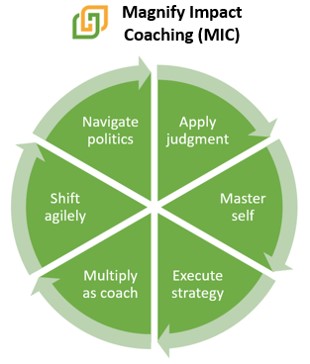
What does it take for a senior leader to jump from good to great? How do they magnify impact?
As an executive coach, I work with senior leaders to improve their effectiveness. Sometimes this involves a serious overhaul of behavior or skills. But most often, the engagement focuses helping already successful leaders to hone existing strengths.
Senior leaders face complex work and challenges. Through my years of experience, I’ve identified a core set of six competencies required for effective senior leaders. I call this my Magnify Impact Coaching (MIC) model.
These 6 competencies have two key characteristics, they are:
- Focused on senior leaders
- Behaviors that can be coached
Some considerations of the Magnify Impact Coaching (MIC) model:
- Senior leader focused. This model focuses on senior leaders. It assumes that the executive possesses key traits or has already learned foundational leadership skills needed to rise to the senior level. See the end of this article for more about the foundations.
- Practical model for coaching. The primary use of this model is to guide executive coaching. As a strong supporter of evidence-based work, I want to clearly note that the MIC model has not been studied as a distinct model. For example, it has not undergone a factor analysis or other kind of data collection study. The individual competencies have research proof, but the unified model does not.
- Consistent with other models. If your company has a formal competency model, you probably see a lot of overlap. Not surprising – these competencies are pretty universal. The terminology might differ. Your internal model likely contains the broader range of leadership competencies like the foundations.
The six competencies of the Magnify Impact Coaching model

Competency 1: Apply judgement
Apply Judgment is the first competency, because it underlies the very essence of being a leader. Senior leaders get paid to apply good judgment in a series of ever-changing situations. These situations often involve complex issues and limited information – which is why human judgement is so critical.
If work was simple, companies could be run by computers and checklists.
Apply Judgement involves assessing situations, making timely and effective decisions and aligning decisions and actions with the expectations of the organization.
Competency 2: Master self

The Master Self competency focuses on personal traits and the ability to control one’s own reactions to situations.
Master Self includes showing resilience, staying calm and steady (shock absorber), and managing one’s own energy and health.
Competency 3: Execute Strategy
Execute Strategy is about being able to get things done and work at the right level. Most leadership competency models separate strategy and execution into two different competencies. This model combines them, because one does not succeed without the other.
Strategic thinking is important, but the strategy must always be realistic in the reality of the business. Some senior leaders get involved in big picture, strategic thinking and forget about execution and sustainability.
True strategy setting does not need to happen very often in most organizations. Senior leaders should probably spend 10% of their time on strategy; 40% of time on execution and 50% time on leading people.
Combining strategy and execution into one competency, leaders can strike the right balance of the two and appreciate how they connect.
Competency 4: Multiply as coach

Senior leaders get work done through other people. Done well, the senior leader multiplies her impact by influencing direct reports who then influence their teams.
Coaching, guiding, motivating and giving feedback are the primary tools a senior leader uses to do their own jobs.
Competency 5: Shift agilely
Our world shifts rapidly – technology, politics, financial markets, consumer demands and more. Shift agilely refers both to having personal openness and to being able to lead change.
Leaders must stay flexible, adaptable and curious. This involves continuous learning, scanning the environment for coming changes and helping teams stay open and flexible.
Competency 6: Navigate Politics
Although the word ‘politics’ has a negative connotation, they are part of life in any human institution – including the workplace. Organizational politics defines how the leader creates influence and gets things done.
It includes influence, organizational savvy, building relationships (peers, direct reports, other functions, superiors, stakeholders, customers, BOD), having executive presence, building alignment and listening to other people.
Foundational traits and competencies

The Magnify Impact Coaching model considers competencies for senior leaders.
This model assumes that certain foundational traits exist and that basic management skills were mastered earlier in career. Some of these are described below.
Foundational traits tend to be inborn and probably cannot be learned. Basic management skills should have been learned as a new supervisor.
Foundational Traits
- Integrity. Integrity provides the foundation of good leadership and of simply being a good person. Integrity can not be taught to an adult or coached, so the leader must already possess integrity.
- Respect. Like integrity, respect (valuing other people) is a fundamental trait. A deeply ingrained belief about respect will not change via executive coaching or leadership development. A change at that core level of belief requires therapy, religious counseling or a dramatic life event. Please note – I am not suggesting that Diversity and Inclusion concepts and behaviors cannot be taught. There is some terrific training around topics like unconscious bias that help people become more aware and change behaviors.
- Cognitive Ability. Cognitive ability – basic intelligence – also cannot be taught. Senior leadership requires good cognitive ability and critical thinking skills. They provide a foundation for complex concepts – such as applying judgement, developing strategy, being a fast learner and more.
Basic Management Skills
Beyond inborn fundamental traits, some basic management skills should be learned early in career. If a deficiency in these basic skills shows up with a senior leader, the coaching would quickly revert back to basics.

- Good performance. The leader knows how to get things done and drive results
- Communication Skills. By the time a leader reaches senior levels, she should be a good communicator. This includes an ability to write effectively, develop a business case, explain via presentations, do public speaking and talk one-on-one with people. Many senior leaders continue to develop skills related to navigating politics and coaching direct reports, but they should have learned the basics.
- Financial Acumen. Financial acumen is another basic requirement for leaders at mid to senior levels. Fortunately, it is pretty easy to develop basic financial acumen – as long as the leader has basic cognitive ability and a willingness to learn. There are many courses available to teach financial concepts to non-financial people.
Over the next few months, I’ll explore and share research related to these 6 competencies as I continue to hone the model.



